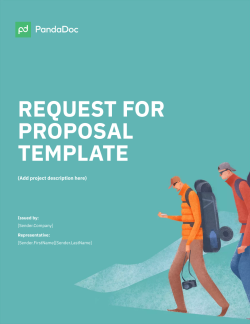When you work with vendors regularly, knowing how to assess the different products and services they offer is vital.
For that to happen, you need to know how to write a request for proposal (RFP).
But what exactly are requests for proposals, and how do you go about putting one together?
In this guide, we’re going to explore them from all angles, starting with a definition.
By the time you’ve finished reading, you’ll know precisely how to craft the best possible RFPs and get the vendor offers you need. So let’s get started!
What is a request for proposal (RFP)?
The name of the term is quite literal. When you submit a request for proposal, you’re quite literally asking (requesting) for vendors to send you their offers (proposals) for work you need doing.
Let’s say, for example, that you’re planning an event and looking for caterers. You would send RFPs to various catering companies to compare their offers and see which best suits your needs.
RFPs are usually sent out when you need work to be done that can’t be handled in-house.
Depending on your resources, needs, and time constraints, you might send out many requests or just a few.
The key is that you should be able to use the responses to compare suppliers.
What is the correct RFP format?
While there is no such thing as one singular request for proposal format that everyone uses, there certainly are conventions and unspoken rules to keep in mind.
For one, it’s always better to use a simple RFP template than an overly complex one.
Your goal is to reach suppliers and explain how they can help you. It’s tough for them to respond if they can’t make head or tail of your document.
When sending electronic RFPs, you’ll want to make sure they can be opened easily across devices.
Documents in PDF format are great for this, as they’ll look the same on mobile and desktop devices and don’t require anyone to have specific software to view them.
So, in short, the correct RFP format is one that’s easily accessible and understandable to vendors.
What should be included in a request for proposal?
There’s no magic formula that will work every single time or for every single vendor you’ll ever work with.
Instead, it’s best to learn the theory behind how to write an RFP, then use templates and start practicing.
Here’s what should be included in your templates.
1. Your scope
If you’re requesting a product, you need to know what quantities you’re asking for.
The same goes for a service, though you’ll also want to include information on how long each one should last.
Additionally, you should be clear about how long your project will take and how far-reaching you intend for it to be.
This lets vendors prepare appropriate offers.
2. Your budget
While this technically falls under the ‘scope’ heading, it’s important to highlight it on its own.
Vendors can’t send you offers if they don’t have a clue how much you’re willing to pay them.
A suitable budget will help vendors determine which packages they can offer you, which lets you make a final choice out of options curated to suit your needs.
3. A short, snappy summary
Great vendors are in high demand, so you’ve got to make things as simple as possible for them.
If you provide them with a concise executive summary at the beginning of your RFP, you’ll save them time and help them reach a decision more quickly.
Summaries are also helpful for your own records since they let you recall at a glance what you requested at a given point.
4. Details on the project
This is for anyone reading past the summary.
Explaining the project’s needs helps vendors determine how they can contribute to it and make it clear whether your two companies are a good match.
In short, if you’re going to work with a provider, they need to understand what they’re signing up for. That’s what this component is for.
5. Information about your company
Who are you, and what makes your business special?
This type of information lets vendors assess whether they’d be a good long-term partner for you.
That’s enormously helpful when you’re scheduling recurring events or setting up other orders that will go beyond a one-time deal.
6. Your requirements
This is the part when you tell vendors precisely what you’re searching for and what you’d like them to provide you with.
If they don’t have any products or services that suit your guidelines, they’ll know right away to tell you no.
Otherwise, they can start comparing their bundles or offers to your requirements right away, so they’re able to present you with the best packages.
You’ll also want to set out what you’re looking for in a response.
This lets vendors communicate with you in the most comfortable way for both parties.
7. Selection criteria
What’s going to help a provider stand out from their competition?
Providing details here will help you make sure you end up with offers that fit your needs as well as possible.
You won’t have to sift through unsuitable proposals, because you clearly established the criteria they’d all be judged against.
How do you write a simple request for proposal?
So, we’ve covered the basics of how to write a RFP that contains all the essentials.
But that doesn’t quite take the fear out of putting in the work to create one, only to be met with silence.
The following best practices will help you ensure you always hear back when you send your RFPs out.
Be clear and concise
The clearer you are, the more likely you are to get a response quickly.
Consider how easy it is to reply to an email that asks you something like ‘When are you available for a 20-minute call?’, versus one that hides its actual request behind lots of jargon and rambling language.
Your goal is to pose clear questions to your prospective vendors so they know exactly what you’re looking for.
As for keeping things concise, a good rule of thumb is to ask yourself how easy it is to skim your request. Is it easy to tell what you’re looking for at a glance?
Can you scan the RFP and come away knowing how to respond? If not, consider trimming it down to the bare essentials.
Communicate your needs
In the same vein, you need to leave no doubts in a reader’s mind about what your proposal is asking for.
Do you have specific budget, time, or product requirements?
These need to be explicitly discussed in the RFP, so vendors don’t need to ask you about them each time.
It’s a little like making a wish with a genie.
You could say ‘give me a bat’ and leave it up to the genie whether you get a baseball bat or a nocturnal creature with wings, or you could ask for ‘a five-course Italian meal that’s pescatarian, gluten-free, and cooked by Michelin-starred chefs’.
In the latter case, you’d be sure to get back something you really love.
All of that is to say that your needs have to be very clear in your RFP in order for any responses to be meaningful.
Use a great layout
We’ve touched on the importance of scannability. Layout, color scheme, and font choice play into this as well.
You’ll want to choose a layout that looks good without being distracting. The color scheme (and other aesthetic choices) should suit your brand identity so vendors know who you are at a glance.
Also, your layout lets you visually demonstrate the relative importance of every component of your RFP.
Include enough information
We know this sounds like a contradiction to the first tip in our list, but bear with us.
‘Scannable’ does not mean ‘sparse’ or ‘vague’.
You need to give your vendors enough to work with, or they’ll either assume you don’t know what you want or give you proposals for what they think you want.
And when you’re unclear, the gap between what it sounds like you want and what you’re actually looking for can be huge.
This is why it’s always vital to make sure you’ve put in enough information.
Can vendors make a clear list of which products or services you’re requesting?
Do they know what your budget looks like? Is there a clear due date on both their proposals and your final decision?
Make sure the answer to all of these questions is ‘yes’.
Set out exactly what you want from vendors
This is further to the point of being as clear as you can – when you expressly state what you’re looking for in a response, you take a lot of work and confusion away from vendors.
They can simply consult your RFP and know what you want.
This lets them jump straight into drawing up the perfect proposal for you and making any adjustments you may need.
Crucially, it also helps vendors state clearly when they can’t help you.
This saves you time and effort you’d otherwise spend chasing them up, and lets you refocus your energy on the vendors whose interests do align with yours instead.
Best request for proposal examples
Next, we’ll walk through some request for proposal examples to give you an idea of how RFPs work in practice.
Website development
One of the most common RFP examples takes the form of companies sending out requests for others to develop their website for them.
They’d simply need to explain what they’re looking for in a company website, then ask developers to create that site for them.
Marketing
Often, companies will send out a request for proposal sample to marketing firms to get help with organizing their own marketing campaigns.
That sample RFP would include details on the product or service in question, as well as the channels they’d like for it to be marketed on.
Construction
Businesses often send RFPs to construction companies when they’re planning to scale up.
These RFPs explain what sorts of buildings they’re looking for.
Request for proposal template
A robust request for a proposal template should include all the items we’ve covered as essential components of an RFP template. It should also:
- Let you know which contexts are best suited for the RFP template in question
- Help you enter your details quickly and easily
- Be free and easily accessible
- Let you customize your request for proposals template to suit your needs perfectly
- Look visually appealing but not overly stylized.
This is how you can tell apart a great RFP template from one you’re better off skipping over.
Promote equal opportunity and transparency with an RFP
Writing an RFP allows you to ask for exactly what you want and to choose the best possible fit in response.
This makes it the ideal tool for creating equal opportunities and boosting transparency across the board.
That’s easier than ever with PandaDoc.
By providing templates that walk you through how to write a request for proposals, PandaDoc helps you get the results you want by writing the ideal RFP in minutes.
All you have to do is choose the template that best suits your needs, then enter your information, and that’s it!
After that, you can send your requests off to vendors without any further worry.
PandaDoc ensures all relevant components are included in your RFP, and that the document’s layout and overall look help you get the best results.
Disclaimer
PandaDoc is not a law firm, or a substitute for an attorney or law firm. This page is not intended to and does not provide legal advice. Should you have legal questions on the validity of e-signatures or digital signatures and the enforceability thereof, please consult with an attorney or law firm. Use of PandaDocs services are governed by our Terms of Use and Privacy Policy.



